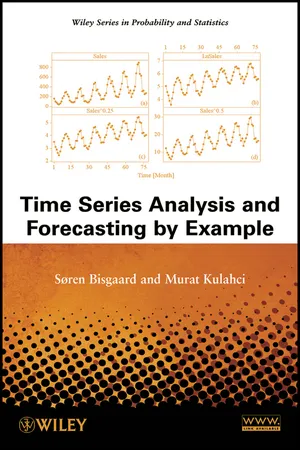
- English
- ePUB (mobile friendly)
- Available on iOS & Android
Time Series Analysis and Forecasting by Example
About This Book
An intuition-based approach enables you to master time series analysis with ease
Time Series Analysis and Forecasting by Example provides the fundamental techniques in time series analysis using various examples. By introducing necessary theory through examples that showcase the discussed topics, the authors successfully help readers develop an intuitive understanding of seemingly complicated time series models and their implications.
The book presents methodologies for time series analysis in a simplified, example-based approach. Using graphics, the authors discuss each presented example in detail and explain the relevant theory while also focusing on the interpretation of results in data analysis. Following a discussion of why autocorrelation is often observed when data is collected in time, subsequent chapters explore related topics, including:
- Graphical tools in time series analysis
- Procedures for developing stationary, non-stationary, and seasonal models
- How to choose the best time series model
- Constant term and cancellation of terms in ARIMA models
- Forecasting using transfer function-noise models
The final chapter is dedicated to key topics such as spurious relationships, autocorrelation in regression, and multiple time series. Throughout the book, real-world examples illustrate step-by-step procedures and instructions using statistical software packages such as SAS, JMP, Minitab, SCA, and R. A related Web site features PowerPoint slides to accompany each chapter as well as the book's data sets.
With its extensive use of graphics and examples to explain key concepts, Time Series Analysis and Forecasting by Example is an excellent book for courses on time series analysis at the upper-undergraduate and graduate levels. it also serves as a valuable resource for practitioners and researchers who carry out data and time series analysis in the fields of engineering, business, and economics.
Frequently asked questions
Information




Table of contents
- Cover
- Series Page
- Title Page
- Copyright
- Dedication Page
- Preface
- Chapter 1: Time Series Data: Examples and Basic Concepts
- Chapter 2: Visualizing Time Series Data Structures: Graphical Tools
- Chapter 3: Stationary Models
- Chapter 4: Nonstationary Models
- Chapter 5: Seasonal Models
- Chapter 6: Time Series Model Selection
- Chapter 7: Additional Issues in Arima Models
- Chapter 8: Transfer Function Models
- Chapter 9: Additional Topics
- Appendix A: Datasets used in the Examples
- Appendix B: Datasets used in the Exercises
- Bibliography
- Wiley Series
- Index